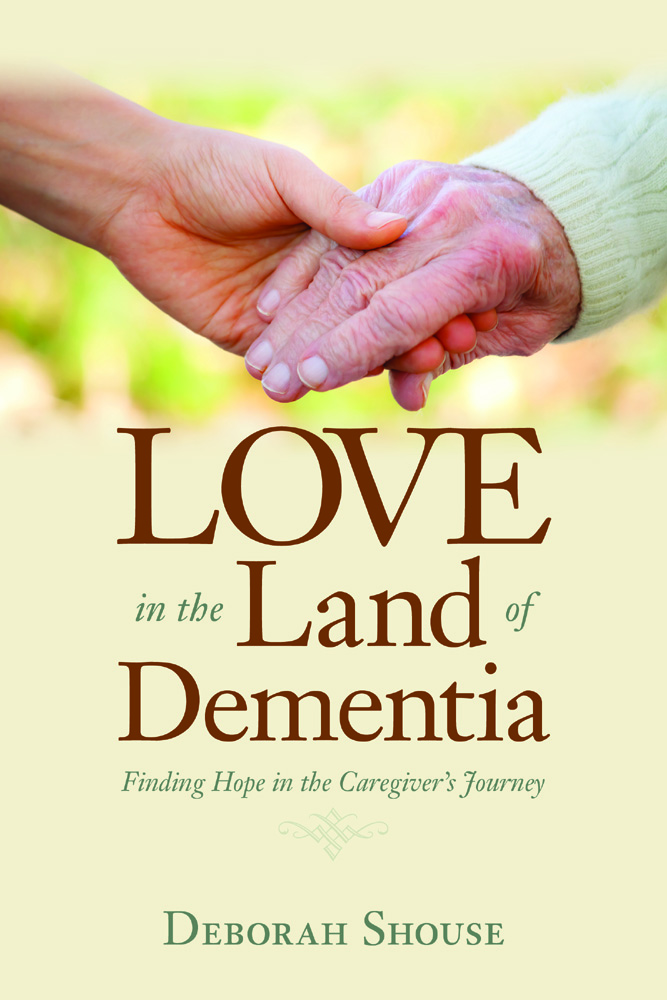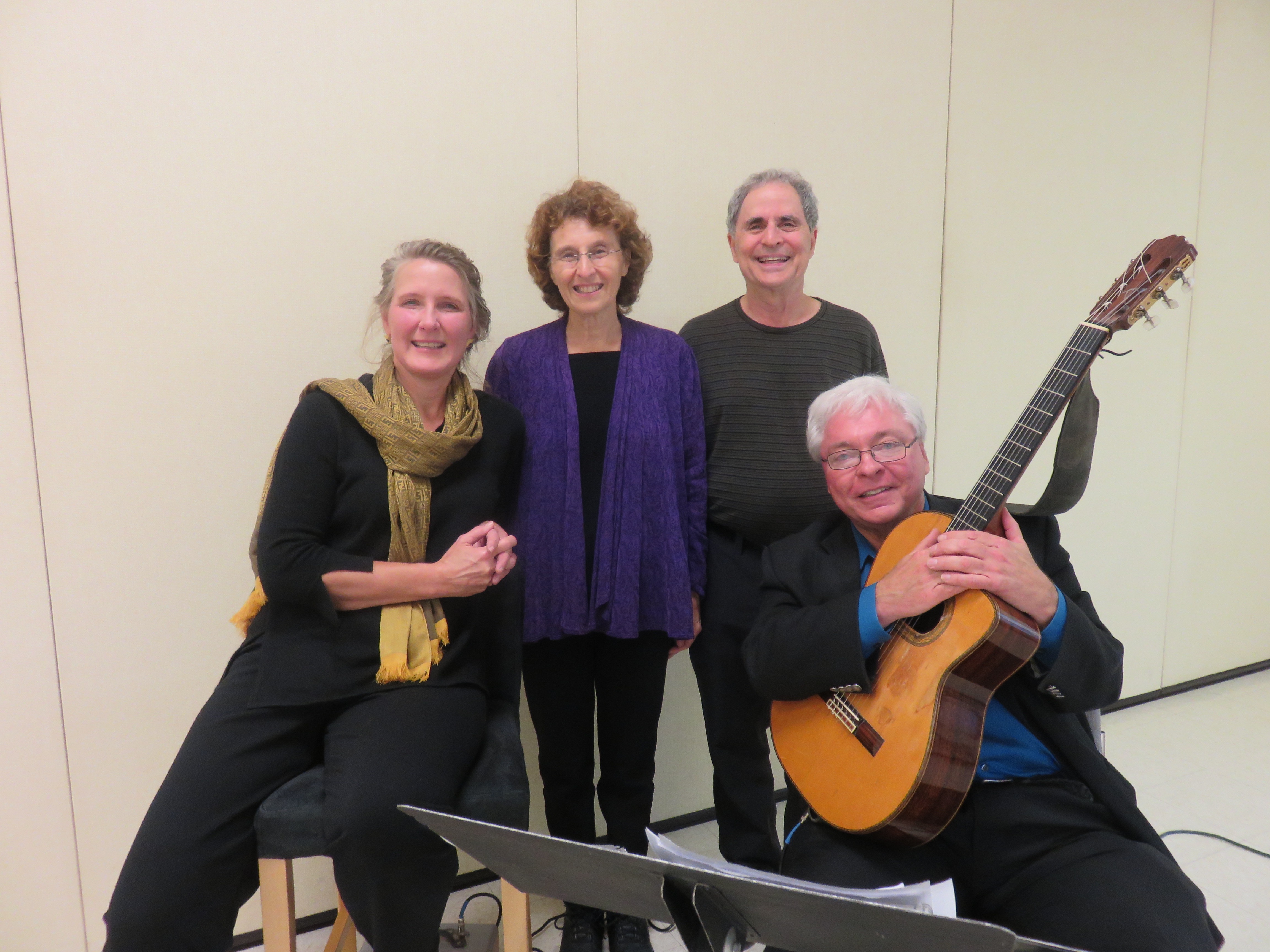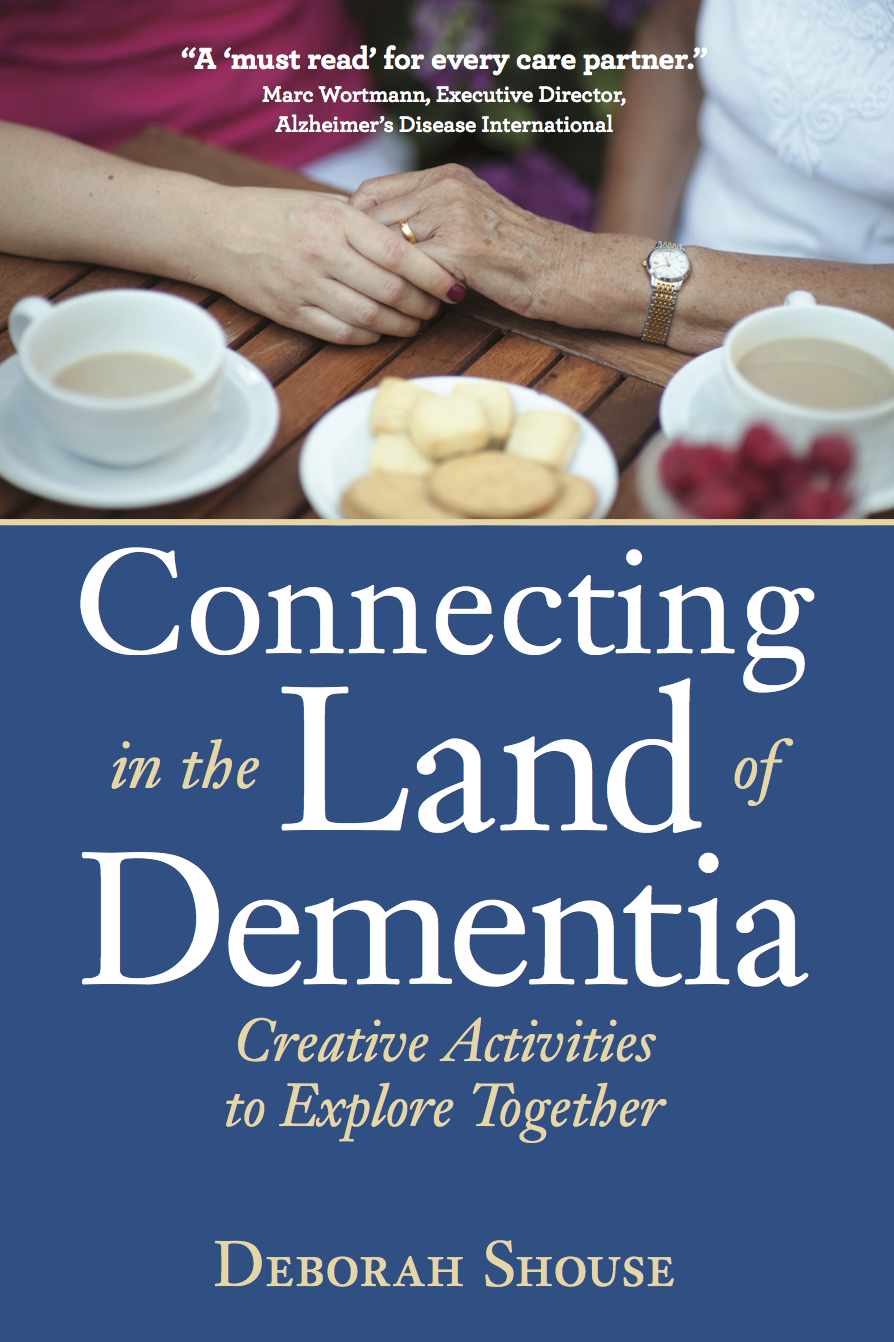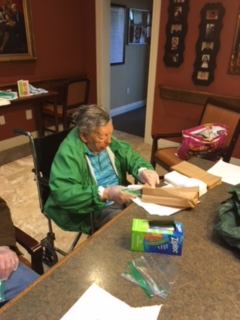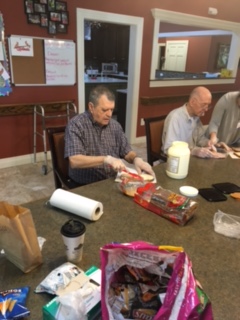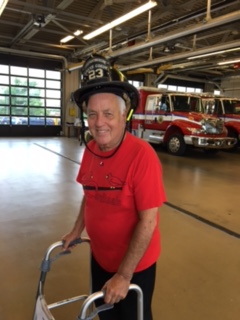Posts Tagged ‘caregiving’
Paradise Lost and Found: Two Women Take Action on Alzheimer’s
Like most visitors to Bermuda, we were interested in the lush sand beaches and warm tourmaline ocean waters. But we were also interested in meeting Liz Stewart and Marie Fay of Action on Alzheimer's. These two women are using their considerable energies, connections, and talents to enrich the lives of Bermudians who are living with dementia. Liz and Marie inspired us with their passion and accomplishments and we wanted you to meet them as well.
~~~~~~~~~
"Now what?"
That was the question Liz Stewart asked after her mother was diagnosed with dementia. It was 2004 in Bermuda and Liz could not find any support services for herself or her mom. She was thrust into the care partner's role without any education on the subject of dementia. Liz knew, "It's not what you know; it's what you can learn," and Liz began learning fast. She soon realized she was not alone. In Bermuda, there were hundreds of people living with dementia. Liz's quest to help her mother turned into a determination to help others living with dementia. She formed a non-profit organization, Action on Alzheimer's, in late 2012. She volunteers her time and works with Marie Fay, an occupational therapist with special dementia training, offering support services, education, and training throughout the islands.
 Liz and Marie are a two-woman transformation team who have gathered other like-minded people.
Liz and Marie are a two-woman transformation team who have gathered other like-minded people.
They provide free dementia training to the island's care communities, hospitals, doctors, and families. They collaborate with local musicians and movement specialists and host frequent expressive arts sessions, including drumming, movement, and singing. They work with government officials, advocating for those who need more resources. And they are talking about the issues, raising consciousness through Alzheimer's Awareness runs, wine-tasting fundraisings, and community events.
Now, when someone is diagnosed with dementia on Bermuda, they don't have to feel totally isolated and confused. They can turn to Action on Alzheimer's.
If you know of other people who are making a difference, please let me know. I love being inspired by the passion and compassion of world-changing souls.
To learn more about Action on Alzheimer’s, visit www.alzbermuda.com

Deborah Shouse is the author of Connecting in the Land of Dementia: Creative Activities to Explore Together and Love in the Land of Dementia: Finding Hope in the Caregiver’s Journey.
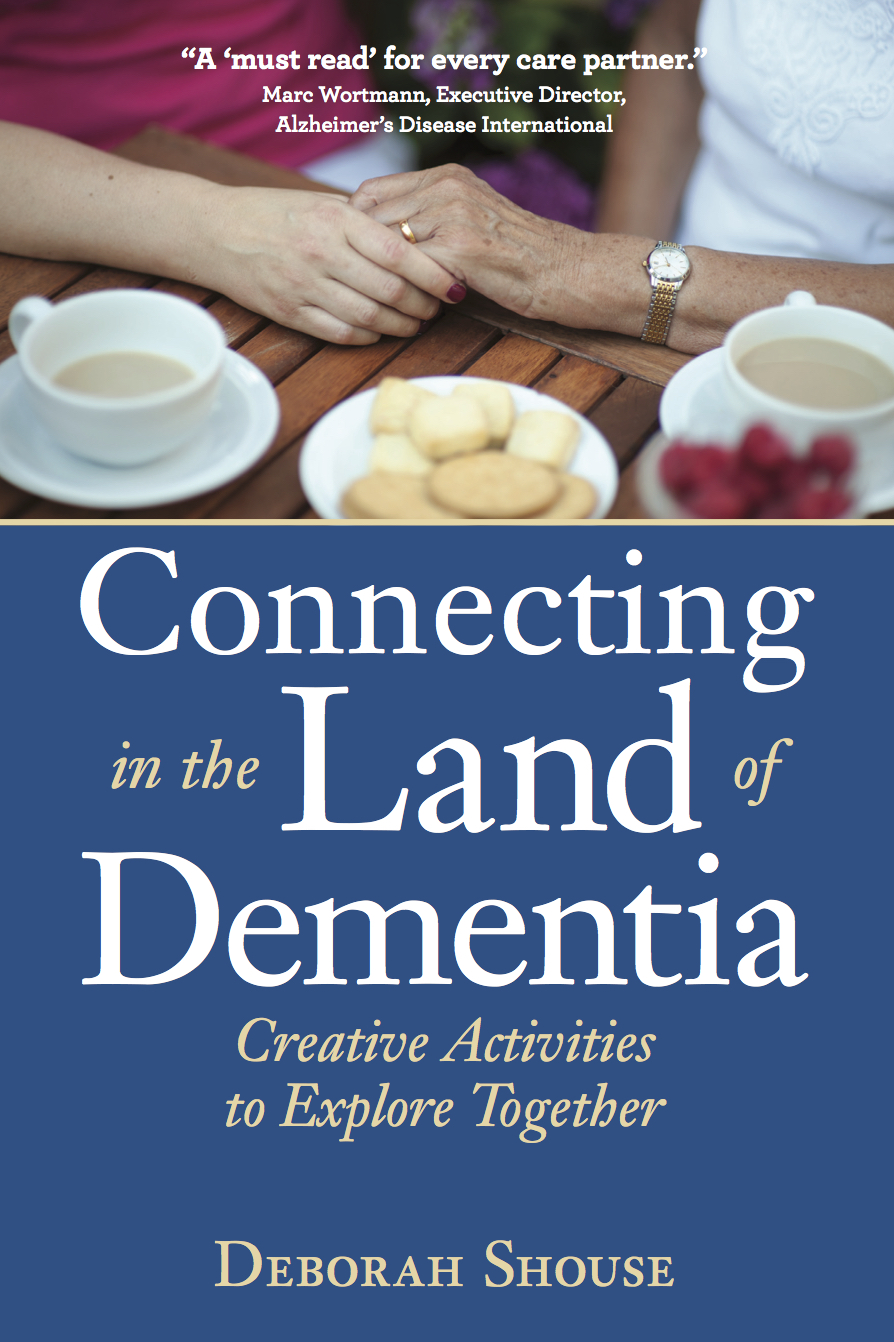
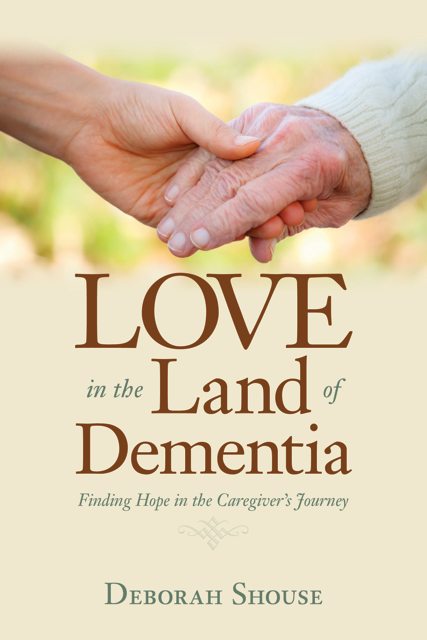
An Inside Look at Creative Aging
We are huddled on the floor, concentrating on our assignment. Each of us has shared an important saying or proverb that impacted our lives and now we are turning those six sayings into a song. We have a daunting five minutes to accomplish this creative task. However, we also have songwriter and musician Vanessa Torres from Lifesongs to guide us. After we've shared our sayings, Vanessa instantly comes up with a theme--These Are Things That I've Learned. Our song centers around that chorus, with each of us weaving in our personal sayings.
In the other three corners of the room, groups are collaborating, turning their sayings into spoken word, dramatic movement, and theatrical improv. Our facilitator, Susan Pearlstein, Founder Emeritus for the National Center for Creative Aging in Washington, DC, and the Founder of Elders Share the Arts in New York City, calls us back to the circle and each group performs their piece. In mere minutes, we have learned something important about each person, we have created an artistic work with people we're just getting to know, and we have appreciated the power of creating something together.
This was an exhilarating beginning to the third annual NCCA conference on creative aging.
These are things I that learned at the conference:
 Every person is inherently creative. Of course, I knew this. But it is so lovely to be reminded in so many ways. It is so lovely to be invited more deeply into your own creativity through song, dance, theater games, art, movement, and brainstorming. It's inspiring to be in a room where so many are expressively at ease with their creative spirits.
Every person is inherently creative. Of course, I knew this. But it is so lovely to be reminded in so many ways. It is so lovely to be invited more deeply into your own creativity through song, dance, theater games, art, movement, and brainstorming. It's inspiring to be in a room where so many are expressively at ease with their creative spirits.
Here are some insights from conference luminaries. Some are not attributed because I was so raptly listening I didn’t write everything down!
“Creativity is a moment when we look at the ordinary, but see the extraordinary.”
“Art is for everyone. It's not a frivolous add-on. It's a vital part of life. Everyone is creative. Dream and dispel the myth that ‘I can't do art.’ Aging has been treated like it’s all gray but it's really expansive colors.” Remarks of Jane Chu, Chairman of the National Endowment for the Arts, Sept 25th, 2016. Click here to enjoy a video of the Chairman
“Feeling useful is a human right.”
“Fifty percent of our elders feel lonely.” Vice Mayor Karsten Klein, The Hague
"By listening closely to one another, we can help illuminate the true character of this nation, reminding us all just how precious each day can be and how great it is to be alive." Dave Isay, founder of StoryCorps, via Eddie Gonzalez
“Bringing what is inside to the outside; it is important to do this as we age.” Mary Luehrsen, National Association of Music Merchants
“Creativity is the connective tissue that we use to build community across diverse differences.” Anne Basting, TimeSlips, ™ Recipient of a 2016 MacArthur Genius Grant
“Instructors need people living with dementia as co-teachers to transform educational goals. “ Dr. Elizabeth Lokon, Opening Minds Through Art
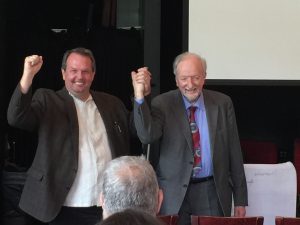
John Killick (right), poet, author and innovator in creativity and dementia, heard this wisdom one day while visiting a memory care community:
“Words of comfort are free, but very necessary.”
“I love it when you hold out your hand and water pours from it.”
“If you don't ask for the moon, you don't even get a piece of cheese.”
“You have to introduce yourself or else it all goes brittle.”
“Life is the slackness, the film and the veil.”
“Every time I look for home, I find you.”
John says, “This tells me that people with dementia are really creative and all we have to do is listen and be enriched.
This is just a soupçon of things that I learned. I wish I could have talked to every person at the conference. I wish I could have listened full on to their stories, to their sayings and proverbs, to the things that they knew and the things they had learned. Which is one reason I hope to return to the conference next year.
Deborah Shouse is the author of Connecting in the Land of Dementia: Creative Activities to Explore Together and Love in the Land of Dementia: Finding Hope in the Caregiver’s Journey.
Shall We Dance?
 Normally, I do not like being the center of attention. But when Sebastian Tomkowski asked me to dance the merengue, I said yes. Actually, my first reply was, "I can't dance." But Sebastian assured me he would guide me, literally, every step of the way.
Normally, I do not like being the center of attention. But when Sebastian Tomkowski asked me to dance the merengue, I said yes. Actually, my first reply was, "I can't dance." But Sebastian assured me he would guide me, literally, every step of the way.
Sebastian is one of the dancers working with Rhythm Breaks Cares (RBC), a non-profit that specializes in bringing the energy and joy of ballroom dance to people who are living with dementia. We were lucky to experience one of RBC's sessions in a New York City care facility.
When everyone was gathered in a circle, Stine Moen, one of RBC's founders, put on some Frank Sinatra tunes. Instantly, one woman danced her way into the room. Her movements were graceful and stylish. When Sebastian invited her to waltz, she readily accepted.
Stine asked a seated women if she'd like to dance. The woman said, "I have this walker and I can't dance with it."
"You can," Stine assured her. "You can use your walker and you and I can dance together."
The woman demurred and sat swaying to the music. But when Stand by Me started playing, she hoisted herself to her feet, grabbed the walker, and began moving rhythmically around the room.
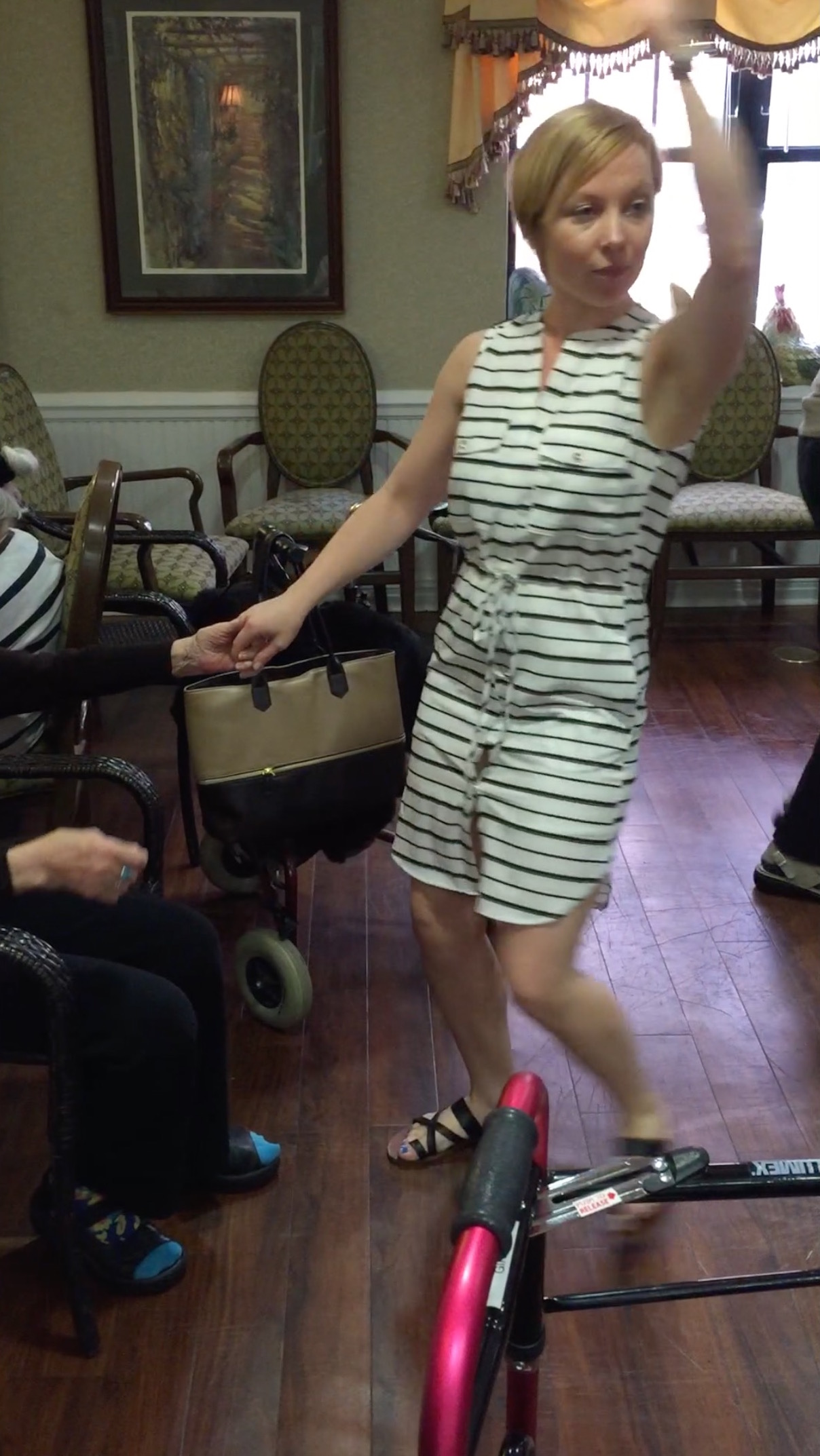 Two men sat in the circle, seemingly not registering the music. When Stine asked if they'd like to dance, one man held out his hand. Stine took his hand and let him guide the movements, while she made fancy arm gestures that looked as though they were waltzing in an elegant ballroom.Click here for dancing ideas.
Two men sat in the circle, seemingly not registering the music. When Stine asked if they'd like to dance, one man held out his hand. Stine took his hand and let him guide the movements, while she made fancy arm gestures that looked as though they were waltzing in an elegant ballroom.Click here for dancing ideas.
One woman sat stock still, but sang along when the song "Fever" played.
"I used to be a singer and my husband played the piano," she told me, when I sat beside her. "But I don't remember the words." She then proceeded to croon along with "I've Got You Under My Skin."
The energy from the music and movement seemed to engage everyone. Even a man who seemed immobile, his mouth tight, his hands clenched up near his face, gradually softened his expression and lowered his hands to his lap.As for me, I reveled in the experience, dancing with the residents or smiling and moving our hands in time to the music. And of course, I loved my once-in-a-lifetime merengue experience.
I asked Stine to offer a few tips for care partners who wanted more movement in their lives.
Here are her suggestions.
"We always start with the music." says Stine. "That sets the tone."
Once the music is playing, if possible, make eye contact. Then smile and hold out a hand. Move in ways appropriate to your partner’s abilities.
Celebrate every movement. Even swaying your arms together to the music is a form of dance.
“It's not about getting the steps right,” Stine says. “It's about connecting through music and movement.”
Want to learn more about the power of dance? Visit the RBC website. Good news—RBC offers training for qualified dancers, so they can bring this exciting program to their own communities.
Click here for additional tips from Stine.
Click here for tips from Sebastian.
Read more about creative programs in Connecting in the Land of Dementia: Creative Activities to Explore Together. Order your copy from your favorite independent or online bookstore.
Deborah Shouse is the author of Connecting in the Land of Dementia: Creative Activities to Explore Together and Love in the Land of Dementia: Finding Hope in the Caregiver’s Journey.

At Long Last: A Page-Turning Love Story
My hands trembled as I reached out my arms. For three long years I’d been working toward this meeting and yearning for this moment. Now, it was finally here. She was more beautiful than I had imagined, with a pleasing weight, just right for holding, just right for spending long hours with. From a glance, her personality seemed strong and purposeful and yet her warm, colorful exterior told me she would be easy to read. As she gradually opened up to me, I felt her power, her accessibility, her willingness to share ideas and wisdom. She felt great; she looked great; and she was brimming with exciting new ideas. Three long years and finally, she was in my arms. I hugged her tightly. At last I was holding my new book, Connecting in the Land of Dementia: Creative Activities to Explore Together
What makes this book unique? It’s the amazing people who contributed to it. During the writing process, I interviewed dozens of innovators across the globe, gathering ideas that engage the creative spirit so you can continue to experience meaningful moments throughout the dementia journey. These luminaries inspired me every step of the way and I am eager to share their ideas with you.
This book is brimming with easy projects using music, art, movies, cooking, gardening, and more. Here are some of the benefits you can look forward to when you do these activities together: Increased energy and socialization, an improved sense of purpose, reduced anxiety, and chances to express yourselves in new and meaningful ways.
Here’s even more good news about the ideas in this book. They’re adaptable for all ages and abilities, and you don’t need to have any special talents. Simply incorporate them into your daily routine and you’ll enrich your time together.
Marc Wortmann, Executive Director, Alzheimer’s Disease International, called the book “A ‘must read’ for every care partner because it really helps you to look at things differently!”
If you’re in the Kansas City area, please join us for the book launch on Sunday afternoon, October 9th, at 1:30 for a reception in the Truman Forum at the Plaza Library. The free presentation will begin at 2:00 This lively program, filled with ideas, stories, and songs, features myself and my partner Ron Zoglin, musical luminaries Rod Fleeman and Cynthia Schroer, and guest speaker Michelle Niedens from the Heart of America Chapter, Alzheimer’s Association.
RSVP 816-701-3407
For those of you in the Washington DC area, please join us at the free Alzheimer’s Foundation of America Caregiver’s Conference on Thursday September 29. We’ll be presenting there, along with other experts in the field. Click here to register.
We recently heard from several readers, saying, “This book is going to help so many people. I’m recommending it to my friends and colleagues.”
That’s what this is all about: enriching people’s lives through meaningful engagement.
It’s a challenge, bringing a new book into the world and we welcome your ideas and help in spreading the word about the book and the event.
You can order a copy now from Rainy Day Books, our book-seller for the event, or online.
Here is some advanced praise:
“A thoughtful and positive guide to the very thing I find myself constantly advocating to doctors, caregivers, and family members—social stimulation and creative arts will limit the need for psychiatric medication and improve the quality of life for those with dementia more than anything else.” Doug Wornell, MD, Life Solutions Group for Geriatric and Neurological Psychiatry
“Buy this book, read it, highlight what inspires you. As you make notes and bend pages to personalize this guide, you are creating a family treasure.” Carol Bradley Burdock, Founder of Minding Our Elders
“Deborah Shouse provides a great public service by shining light on the numerous creative activities that can meaningfully engage the minds and spirits of persons living with dementia. From personalized music to storytelling, Shouse makes it easy for caregivers to understand the various options they have to help their loved ones navigate through their everyday lives.” Dan Cohen, MSW Founding Executive Director, MUSIC & MEMORYsm
Three Benefits of Artistic Alchemy
Last week, I wrote about Julian West and his work with music and dementia. Hannah Zeilig, PhD, is an expert in culture, language, and dementia, who participated in and documented Julian’s program. When I interviewed Hannah, I was inspired by her perspective on arts and communications and wanted to share a few of her key ideas.
“The project showed us that you can converse in so many ways,” says Hannah. “The musicians and the dancer reminded us that we all can communicate without language.”
“One of the questions we’re asking in the UK is ‘How can the arts help with dementia? What can arts do that a game of dominoes cannot?’ ” Hannah says. “The arts help people become brave in how they connect with each other.”
The arts also transcend our dependence on achievement, identity, and memory.
“Being scared of dementia is the biggest barrier,” Hannah says. “In our language and our media, dementia is stigmatized and portrayed as catastrophic. One of the natural and common fears is summarized by this: ‘If I can’t remember where I live and my achievements, how do I know who I am?’
Julian’s work reminds us that we are all creative.
“People with dementia can be brimming with creativity and humor and able to make connections with each other,” Hannah says.
During one of Julian’s sessions, the musicians were playing and the dancer was cavorting around the circle. One resident, Alicia, walked right up, took the dancer’s hands and lead her in a waltz.
At the end of the dance, Alicia was glowing. She smiled and said, “We really just did something.”
And she was right.
….
Other gifts from this work in the arts:
- The residents communicated with more sounds and gestures.
- The staff saw the creative side of the residents.
- The creative atmosphere opened everyone up to alternate ways to connecting.
For more about Hannah and her work, visit:
Orchestrating a Musical Conversation
When Ron’s dad was living in a memory care unit, Ron and I talked with the residents and their families, learning about their favorite songs. We orchestrated a sing-along and had fun working with everyone and putting together a scrapbook of each resident’s special tunes. The combination of music and conversation created a sense of community for us all. Julian West, who we met on a recent trip to London, is creating community through engaging people in music and dance. We really love the way he weaves the two art forms together and wanted to share his easy and adaptable ideas with you.
Julian West had no idea what would happen at the care facility, but he trusted it would be something wonderful. An accomplished oboist and a teacher at the Royal Academy of Music, Julian assembled a violist, a composer, a dancer, and an artist to share energy and their art with people who are living with dementia.
“This was an experiment to see what could happen,” Julian says. “We worked completely improvisationally.”
Once a week, for eight weeks, the troupe came to the residential care home and created a living arts experience with residents and staff. They began by inviting everyone to choose a percussion instrument, such as rain sticks, bells, shakers, tambourine, etc.
“We had a musical conversation,” Julian says. “One person made a sound and another answered. We also chatted a lot. People commented on the music or expressed an emotion or impression.”
The musicians added their instruments and the staff and residents joined in, through percussion and voice. They made fascinating sounds, like an improv jazz singer might do. The dancer twirled around in the center of their circle. Her free movements gave the group a focal point and inspired others to explore various movements.
“I let go of preconceptions and tried to create an open atmosphere,” Julian says.
The artists’ openness helped the “conversation” grow and blossom.
One woman who was living with dementia held up a tambourine, keeping it still and gazing at it as though it were a beautiful and revered object.
Julian’s first thought was, “She doesn’t know it’s a musical instrument”.
“I let that thought go,” he says. “I saw how expressive she was. Her interaction with the tambourine was beautiful and profound and she allowed us all to see the instrument differently.”
Even if you don’t have your own musicians and dancers at home, you can still create this supportive and creative atmosphere.
- Share a few percussion instruments, put on some music you both like, and make some joyful noises. Experiment with bee-bop syllables to add a sense of freedom.
- After the song, talk about the experience, what you liked, what you felt, and any other impressions that came up.
- Consider inviting a “guest dancer,” someone who likes to move to music, or a child of a friend who’s taking dancing lessons. Go ahead and add your own moves.
- Invite friends and family to join you. You’ll have something to laugh, and sing, and talk about.
For more information about Julian’s work, visit: www.julianwest.co.uk
Tips from a Parisian Artist
 There’s something magical about visiting an artist in his studio. Especially if that studio is in Paris. We were honored to meet Patrick Laurin, artist and art therapist, on a recent trip to France.
There’s something magical about visiting an artist in his studio. Especially if that studio is in Paris. We were honored to meet Patrick Laurin, artist and art therapist, on a recent trip to France.
In the beginning, Patrick Laurin’s work with people who were living with dementia went slowly. When he first visited the care home and invited people to join him for painting, he heard various reasons the idea wouldn’t work. “I can’t hear you.” “I can’t see you.” “I can’t move my arm.”
 Patrick, who had quit working as researcher in the pharmaceutical industry so he could create deeper connections with clients, understood the importance of building relationships. Gradually, he got to know the people who lived in the community. He wanted to tailor an artistic experience specific to each person’s abilities and needs.
Patrick, who had quit working as researcher in the pharmaceutical industry so he could create deeper connections with clients, understood the importance of building relationships. Gradually, he got to know the people who lived in the community. He wanted to tailor an artistic experience specific to each person’s abilities and needs.
Over time, the people who couldn’t see, hear, or move were all happily involved in painting.
One woman seemed to blossom when holding the brush and stroking on the paint. Even though she couldn’t later remember to say, “I’ve been painting,” she enjoyed the experience.
One day, Patrick was on another floor in the care community when he encountered this woman and her daughter.
Her daughter said to Patrick,” You are the painter.”
Patrick was thrilled her mother had been able to mention the art therapy sessions. But before he could respond, the mother said, “No, the painter is me.”
“Inside, she was seeing herself as an artist,” Patrick says. “The painting strengthened her identity.”
 Patrick has learned to approach each person with flexibility. Sometimes Patrick jump starts his artists with a squiggle of color on the page. Then he steps back to let them respond with their own squiggle. If they’re stymied, he offers a choice of two colors.
Patrick has learned to approach each person with flexibility. Sometimes Patrick jump starts his artists with a squiggle of color on the page. Then he steps back to let them respond with their own squiggle. If they’re stymied, he offers a choice of two colors.
He also uses collage techniques to inspire his artists. He selects three separate pictures, each with one recognizable thing, such as a house, tree, or dog. He shows the photos to the artist, and asks, “Which one of these attracts you?” When the artist chooses a photo, Patrick then asks, “Where would you like to put this on the paper?” He and the artist apply paste to the paper.
“We don’t turn over the picture and apply paste, because the image then disappears and that can be confusing,” he says.
When the picture is glued to the paper, Patrick discusses a color that’s already in the picture.
“You could take the blue in the sky and extend it,” he might suggest. This suggestion often inspires the artists to start painting. If they get stuck, Patrick says, “What might look good near the house?” In this way, the painting expands.
For one woman, painting began as a series of colors and grew into a personal story.
She pasted a house and began expanding the lawn. Then she drew a bridge and weeks later, she added in a dog. At first, she was painting “a house, a bridge and a dog.” As the picture took shape, she said, “This is my house and my dog and this is the bridge we had to cross to get to the house.” The process of painting had loosened memories of her childhood home.
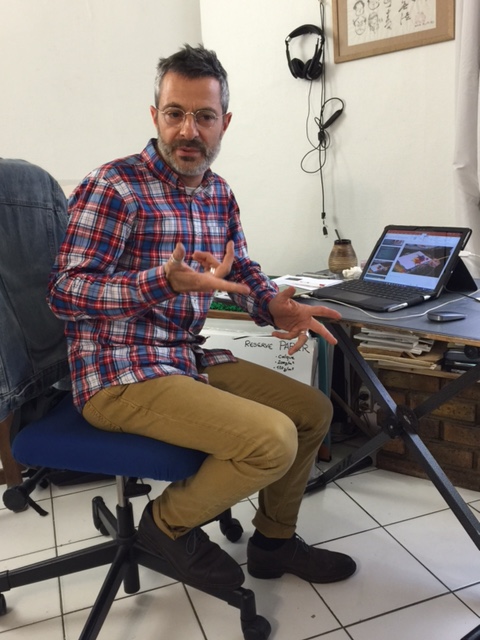 “When I share a piece of art by one of my students, I also share the story behind it,” Patrick says. “The act of creation is more important than the results.”
“When I share a piece of art by one of my students, I also share the story behind it,” Patrick says. “The act of creation is more important than the results.”
Tips:
Pick something that is easy for you, the care partner.
Put a point of color on the pages, then stand back. Offer support but don’t paint.
Enjoy the process and don’t get stuck on the results.
Thanks to Berna Huebner, founder of the Hilgos Foundation and co-producer of the documentary, “I Remember Better When I Paint,” for suggesting we meet with Patrick.
Get Cooking on Giving Back
The assembly line stretched around the spacious dining room table and each person focused fully on his task. One man spread mayonnaise on bread. Another placed turkey slices and another added cheese. Another slipped the sandwich into a baggie and others assembled the lunches, adding potato chips and a cookie. All worked diligently; there was a special purpose to this meeting of the Men’s Club at Dolan Memory Care Homes in Creve Coeur, Missouri. They were giving these homemade meals to the fire fighters in their community as a way of showing their appreciation.
Ten residents of varying abilities, including all levels of memory impairment, contributed to the sandwich brigade. Those who needed help had an assistant with them.
“The participating residents were filled with high energy and good spirits,” says Mary Kate Halm, LMSW, Admissions Coordinator of Dolan, who organized the activity. “They were excited to be engaged.”
The local fire department had invited the group to tour the station when they delivered the lunches. The experience included opening up the sides of the fire truck. One of the residents, who was usually indifferent to outings, used to be a tool designer. When he saw the tools in the fire truck, his eyes grew wide and he became very animated.
“Everyone enjoyed being engaged in a purposeful activity. They loved the tour and they asked excellent questions,” Mary Kate says. They wanted to know the details of their training, how much each truck cost, how much their equipment weighed, and more. The residents weren’t the only ones engaged.
“The firemen loved the attention,” Mary Kate says. “Plus, they were patient, communicated clearly, and were considerate of those in walkers and wheelchairs.”
The community volunteer activity generated a lot of joy and curiosity.
“They were completely connected to the experience,” Mary Kate says. “They were learning, they were giving back, and they were fully present. We created a moment of joy and that’s all that matters.”
Get ready to give back:
Mary Kate offers these tips for connecting with the community and giving back.
- Look for a service organization that you admire. This can be emergency responders such as fire fighters, police, sheriffs, EMTs, as well as animal rescue teams, cancer support organizations, and more.
- Find a project that’s fun for you and for the person living with dementia, a project you can both participate in. If you have friends and family who’d like to help, this is a great time to get others involved.
- Coordinate with the organization and find a time to deliver your gifts. If it’s of interest, ask for a chance to learn more about the organization.
For more interesting activity ideas, visit https://t.e2ma.net/message/gxreo/4bbql
How to Create a Network of Dementia Friends
Ron and I recently traveled to Europe and we were lucky to meet with several creative thought leaders working in the field of dementia. Over the next weeks, we’ll share some of their insights with you, ideas we can incorporate into our every day lives as care partners, friends, and dementia advocates. We met with Philippa Tree, Senior International Officer Alzheimer’s Society UK, in a charming coffee shop located near the Tower of London.
The U.K. has more than one and a half million Dementia Friends, and 10,000 Dementia Friends Champions, volunteers who deliver the Information Sessions. Their goal–four million Dementia Friends in the next two years.
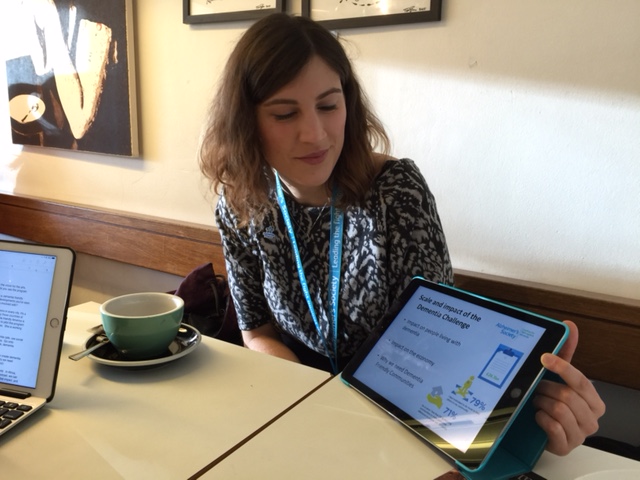 Philippa Tree is part of the Dementia Friends team at Alzheimer’s Society UK. The Dementia Friends programme is a social action movement that aims to transform the way England and Wales think, act, and talk about dementia. It started in 2012 when the Prime Minister of the United Kingdom, in partnership with Alzheimer’s Society UK, urged his country to focus on building dementia-friendly communities. He became a Dementia Friend and challenged others to join him.
Philippa Tree is part of the Dementia Friends team at Alzheimer’s Society UK. The Dementia Friends programme is a social action movement that aims to transform the way England and Wales think, act, and talk about dementia. It started in 2012 when the Prime Minister of the United Kingdom, in partnership with Alzheimer’s Society UK, urged his country to focus on building dementia-friendly communities. He became a Dementia Friend and challenged others to join him.
The free Dementia Friends Information Sessions help people understand what living with dementia might be like. The sessions also offer small action steps so people can make a difference to those affected by dementia in their community. Anyone of any age can be a Friend by attending an information session or watching an online video.
Philippa’s work with Dementia Friends extends beyond the UK and across the world. She’s recently been collaborating with partners in the United States to roll out a pilot Dementia Friends program in the near future. At the recent Alzheimer’s Disease International Conference in Budapest, Philippa facilitated a session with countries including Nigeria, Germany, Israel, Scotland, Canada, and Indonesia.
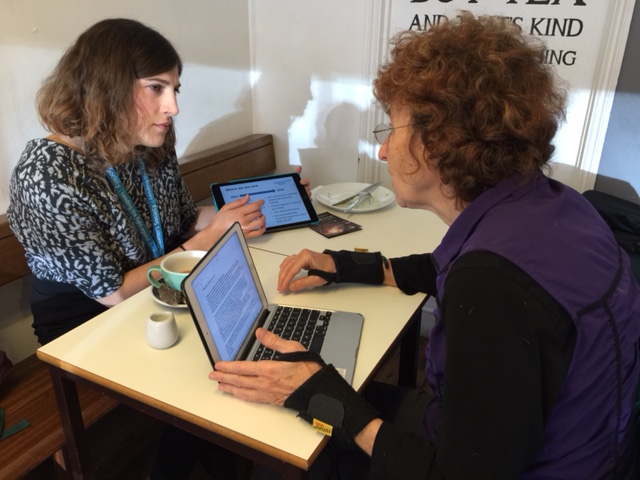 “After only two years, Dementia Friends has become one of the UK’s biggest social movements on any disease.” Philippa says. “We’re working on using positive language and spreading positive messages as we tackle the stigma around dementia. My current role is to support countries worldwide to implement a Dementia Friends program, and to learn and share experiences.”
“After only two years, Dementia Friends has become one of the UK’s biggest social movements on any disease.” Philippa says. “We’re working on using positive language and spreading positive messages as we tackle the stigma around dementia. My current role is to support countries worldwide to implement a Dementia Friends program, and to learn and share experiences.”
While Philippa and her team are working in England and Wales, and worldwide, each of us can make a difference on a local level. Here are examples of action steps people have enjoyed taking:
- Share positive stories about friends and family who are living with dementia. This helps reduce the social stigma.
- Volunteer for creative programs and events for those who are living with dementia.
- Spend time visiting family and friends who are living with dementia.
- Talk to other care partners and ask how their lives are enriched through their caring experiences.
For more information about the Dementia Friends programme, please visit their website : www.dementiafriends.org.uk.
Deborah Shouse is the author of Love in the Land of Dementia: Finding Hope in the Caregiver’s Journey.
COMING SOON: CONNECTING IN THE LAND OF DEMENTIA: CREATIVE ACTIVITIES TO EXPLORE TOGETHER
A Toolkit for Art Activities
“We’re going to talk about birds today and the beautiful sounds and colors they bring to our lives,” Dalia Gottlieb-Tanaka, PhD tells her client Sylvia, who was an art teacher before she was diagnosed with dementia. Dalia, the founder of the Society for the Arts in Dementia Care in British Columbia, hopes to reconnect Sylvia with her love of birds and invite out her creative abilities through discussion and painting.
“When people living with dementia have purposeful activity while interacting with others, they’re less depressed,” Dalia says. “They find more satisfaction in life. Those who’ve been indifferent and bored suddenly show desires and interests.”
Dalia conceived and developed the Creative Expression Activities Program for people living with dementia. The comprehensive program is based on the individual and includes nurturing body/soul and mind aspirations, improving the physical environment, and training family members and caregivers in their daily interactions. The program emphasizes the importance of activities that encourage creative expressions. As a result, it has the potential to reduce anxiety and stress to both client and care partner and increase the quality of life for both.
Creating a Multi-Sensory Experience
First, Dalia creates an environment rich in visual and sound affects, such as pictures of local and foreign birds, which are either from library books, magazines or calendars. She plays birdsong in the background and shows a short video on birds that was borrowed from a local library or downloaded from YouTube. Dalia orchestrates a discussion about the video, asking what Sylvia liked about it and what it made her think about. She asks open-ended questions, such as, “What do you like about birds? What are your favorites? What kind of bird would you like to be?” She spreads feathers on the table for tactile stimulation.
“Since people have different levels of cognitive and physical abilities, I try to engage as many senses as possible,” Dalia says. “That way, I increase the level of communication and involvement. For example, those who cannot hear well may still be able to smell and touch.”
After the conversation, Dalia passes out paper and invites Sylvia to paint or draw with her. They may start a picture in tandem with Dalia asking Sylvia which bird she’d like to draw.
“Doing creative activities together enriches both individuals and the relationship,” Dalia says.
Creative Sparks
• Apply Dalia’s flexible approach to arts activities to any relevant topic that might interest you and your partner.
• Adapt the ideas to meet your partner’s attention span.
• Think of a subject the two of you would enjoy exploring. Have fun collecting photos, music, video clips, and art supplies. If preparation feels too hard, ask a friend to help, or use a simplified version of this activity.
• Introduce the project, mentioning ways you both can participate. Let your partner know, “This is just for fun. There’s no right or wrong way to do this.”
• At least ten minutes before you’re ready to end, let your partner know you’re winding down.
• Work as equals, side by side, encouraging and helping as needed.
• If desired, post your artworks and share with others.
###
For more information about Dalia and her work, visit www.cecd-society.org
Consider attending the CECD 7th International Conference, September 8-10, 2016, in Vernon, BC, Canada.
Deborah Shouse is the author of Love in the Land of Dementia: Finding Hope in the Caregiver’s Journey.
COMING SOON: CONNECTING IN THE LAND OF DEMENTIA: CREATIVE ACTIVITIES TO EXPLORE TOGETHER



